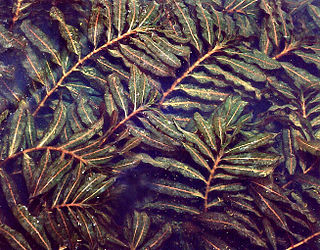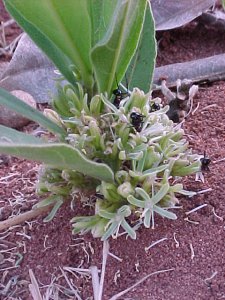
Oxalidales is an order of flowering plants, included within the rosid subgroup of eudicots. This group comprises six families that contain approximately 2000 species in 58 genera. They are trees, shrubs or woody vines which are found in the wet tropics, particularly on mountains, and warm temperate zones, especially in the southern hemisphere. Compound leaves are common in Oxalidales and the majority of the species in this order have five or six sepals and petals. The following families are typically placed here:

The Potamogetonaceae, commonly referred to as the pondweed family, is an aquatic family of monocotyledonous flowering plants. The roughly 110 known species are divided over six genera. The largest genus in the family by far is Potamogeton, which contains about 100 species.

Virola is a genus of medium-sized trees native to the South American rainforest and closely related to other Myristicaceae, such as nutmeg. Species are known commonly as epená, patricá, or cumala. They have glossy, dark green leaves and clusters of tiny yellow flowers, and may emit a pungent odor.

The family Pandaceae consists of three genera that were formerly recognized in the Euphorbiaceae. Those are:

Chrysobalanaceae is a family of flowering plants, consisting of trees and shrubs in 27 genera and about 700 species of pantropical distribution with a centre of diversity in the Amazon. Some of the species contain silica in their bodies for rigidity and so the mesophyll often has sclerenchymatous idioblasts. The widespread species Chrysobalanus icaco produces a plum-like fruit and the plant is commonly known as the coco plum.
Ctenolophon is the only genus in the flowering plant family Ctenolophonaceae. It has two recognized species:

Dichapetalaceae is a family of flowering plants, consisting of 3 genera and about 170 species. Members of this family are trees, shrubs or lianas found in tropical and subtropical regions of the world.

Erythroxylaceae is a family of flowering trees and shrubs consisting of 4 genera and 271 species. The four genera are AneulophusBenth., ErythroxylumP.Browne, NectaropetalumEngl., and PinacopodiumExell & Mendonça. The best-known species are the coca plants, including the species Erythroxylum coca, the source of the substance coca.

Ixonanthaceae is a pantropical flowering plant family of trees or shrubs, consisting of about 30 species in 3 or 4 genera. It is a broadleaf evergreen.

Picrodendraceae is a family of flowering plants, consisting of 80 species in 24 genera. These are subtropical to tropical and found in New Guinea, Australia, New Caledonia, Madagascar, continental Africa, and tropical America. Its closest relatives are Phyllanthaceae.

Trigoniaceae is a family of flowering plants, consisting of 28 species in five genera. It is a tropical family found in Madagascar, Southeast Asia, Central and South America.

Ruppia, also known as the widgeonweeds, ditch grasses or widgeon grass, is the only extant genus in the family Ruppiaceae, with eight known species. These are aquatic plants widespread over much of the world. The genus name honours Heinrich Bernhard Rupp, a German botanist (1688-1719). They are widespread outside of frigid zones and the tropics.

Tapisciaceae is a family of flowering plants. Until recently it had been abandoned by taxonomists, and it was not recognised in the APG II system of 2003. In the APG III system, however, it has been reinstated to encompass the two genera Tapiscia and Huertea, with a total of six known species.

Gerrardina is a genus of two species of trees, shrubs, and scrambling shrubs found in southeastern Africa. Until recently, the genus was placed in the polyphyletic family Flacourtiaceae, but it was abnormal there due to its apical placentation, small embryos, and mucilaginous foliar epidermis. Analyses of DNA data indicated that the genus did not fit in any known plant family and not clearly in any then-recognized order, and a new family, Gerrardinaceae, was thus created for it. Later analyses of additional DNA data and data from wood anatomy indicated that the family should be placed in the order Huerteales.
Setchellanthus caeruleus is a species of pungent shrub with large blue flowers. It is placed alone in the genus Setchellanthus, which is in turn, is placed alone in the family Setchellanthaceae. It is endemic to Mexico.

Sphenoclea is a genus of succulent erect annual herbs. They occur in damp habitats throughout the tropics.

Calophyllaceae is a family of flowering plants in the order Malpighiales and is recognized by the APG III system of classification. Most of the 14 genera and 475 species included in this family were previously recognized in the tribe Calophylleae of the family Clusiaceae. The Angiosperm Phylogeny Group determined that splitting this clade of genera off into their own family was necessary.

Lebrunia neglecta is a species of sea anemone in the family Aliciidae. It is found in the Caribbean Sea and Gulf of Mexico.

Lebrunia coralligens, commonly known as the hidden anemone, is a species of sea anemone in the family Aliciidae. It is found in shallow water in the Bahamas, the Caribbean, and Brazil. It lives in fissures in corals and rocks.
















